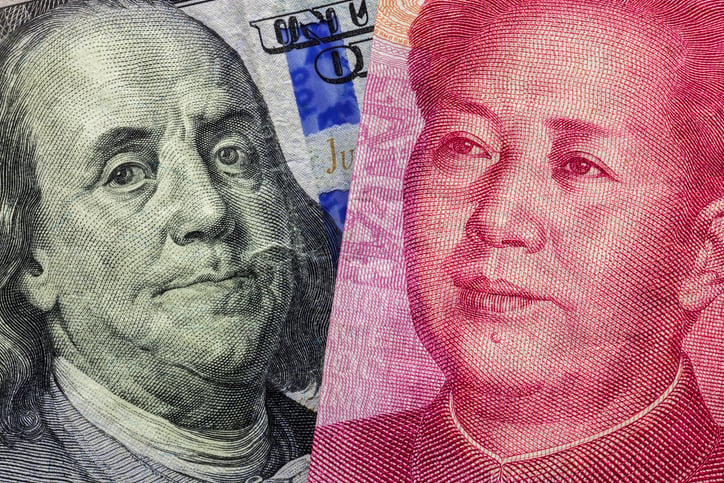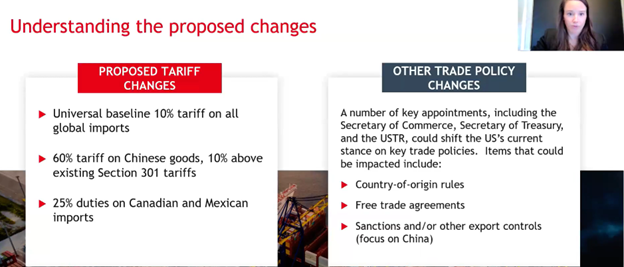Navigating a New Trade Environment That Is More Than Tariffs

It’s been eight years since the dawn of the tariffs era, and Trump tariffs 2.0 is on the horizon. But as Donald Trump prepares to return to the White House, 2025 is not 2017.
In the interim, supply chain organizations have weathered the coronavirus pandemic and developed new risk management and value-add strategies.
And this time around, “the (potential) changes that we’re hearing of late and (those) during Trump’s first administration have changed the landscape around trade, making it the forefront for many companies as they look to drive business and market competitiveness,” said Mathew Mermigousis, national practice leader and vice president, customs and international trade services at accounting and advisory firm BDO USA.
A panelist during Institute for Supply Management®’s (ISM®) “Navigating Potential Tariff and Trade Policy Changes In 2025” webinar last week, Mermigousis said that this iteration of the trade landscape focuses on more than tariffs.
“It’s also looking at restriction of investments in China and in Russia and in other jurisdictions,” he said, as well as the timing of the United States-Mexico-Canada Agreement (USMCA) renewal. “There’s also landscape around ESG (environmental, social and governance) factors, modern slavery and forced labor.”
Also impacting the trade scene, particularly manufacturing and imports: A number of key appointments, including the Commerce and Treasury secretaries and the U.S. Trade Representative, could shift the country’s current stances on key trade issues like country-of-origin rules, said Ashley Hetrick, principal sourcing and supply chain segment leader at BDO USA.
A Review of Tariff Proposals
These factors are not to preclude potential tariff hikes, which could come to fruition shortly after Trump returns to office next week:
- A universal 10-percent baseline tariff on all global imports. This is designed to incentivize manufacturing and distribution businesses in the U.S., Hetrick said.
- A 60-percent tariff on Chinese imports. “That would be in addition to the Section 301 tariffs which came into effect earlier this year and have cascaded over the last few years, significantly (increasing) the cost to import goods from China to the United States,” she said.
- A 25-percent added duty on Canadian and Mexican imports. “Those are being proposed more as an incentive for those governments to support U.S. policies against drug trafficking and other types of illegal activity flowing across the border by penalizing good importation from those companies or from those countries as a negotiation tool,” Hetrick said.
Immediate Impact
In addition to increased trade landscape differences, the Trump tariffs 2.0 proposals are broader and encompass more trading partners, Mermigousis said.
Another difference: The changes are designed to achieve various foreign and domestic policy objectives such as drug enforcement and immigration, he said.
Immediacy is another point of inflection. Historically, presidents have used regulatory mechanisms to increase tariffs and manage the trade landscape, he said. Those regulations or requirements have structured steps and review processes, and they provided companies some time for preparation and to adapt, he said.

Ashley Hetrick, principal sourcing and supply chain segment leader at BDO USA, discusses potential tariff and trade policy scenarios during Institute for Supply Management®’s (ISM®) “Navigating Potential Tariff and Trade Policy Changes In 2025” webinar.
However, President-elect Trump is considering issuing executive orders “to implement significant portions of his trade policy on Day 1,” Mermigousis said. This can be done under what’s called the International Emergency Powers Act (IEPA), which essentially indicates there is a national security concern for issuing the orders to impose tariffs, he said.
“This means that they can go into play, as quickly as (January) 21, which doesn’t give companies a whole lot of time to adapt — because we still don’t know what will be encompassed in the executive orders,” he said.
Scenario Planning as a Tool
Still, due to the pandemic, many organizations have committed to scenario planning, strategizing and risk management. Another panelist, Collins Oluka, MBA, CPSM, head of global procurement and strategic sourcing at Velcro Companies, said that his company had conducted internal analysis: “We started doing robust scenario planning, crafting different types of potential outcomes and what those impacts would be for the Velcro Companies,” he said.
Results were presented to the executive leadership team to build awareness and, he said, “bring them up to speed, so that if anything happens, they have enough insights to help us with decision-making.”
During the past few years, he said, the global supply chain has faced, in addition to COVID-19, challenging situations like port congestion, shipping delays, geopolitical tensions related to the Red Sea and wars, which have underscored the vulnerabilities with global supply chains.
“So, we are being very proactive in terms of driving different types of conversations, based on different categories such as exploring multiple sources and localization,” Oluka said. “The goal is to is to strategically reduce our dependency on China and in the long run strengthen our supply chain.”
Strengthening Procurement’s Role
Conducting internal analyses will help organizations weather the latest challenges to the trade environment, said Peter Terilli, principal global value chain and international tax at BDO USA. “Figure out what’s going on and where the business wants to go,” he said. “Are they making different changes? How are they making different changes, and what are those going to be based on?”
From there, companies can ask such questions as: if we’re going to be diversifying our supply chain, where will we move? Will we shift out of China or set up a China-plus-one policy? Are we going to want to nearshore (or) onshore?”
Onshoring could be the costliest consideration of the upcoming trade landscape, Terilli said. “There aren’t a lot of companies that are going to want to invest a ton of capital in the U.S. and not know exactly how long tariffs are going to be in place,” he said.
When diversifying location and production, organizations must look at not only the local benefits of a shift but also their tax profile and footprint, he said. If they don’t want to make the capital investment required to shift manufacturing operations to the U.S., perhaps there are other value drivers, like R&D, that can be moved, he said.
Hetrick said that the potential new trade landscape offers opportunities for procurement organizations.
“Part of what’s really interesting about this tariff policy (and) the incoming administration’s typical stance on corporate taxes, which is (establishing) some of the lowest corporate tax rates the U.S. has ever seen, is it creates a huge incentive for procurement activities to be located within the U.S.,” she said.
The more advantageous corporate taxes can offset some of the labor cost difference that has led a large portion of the profession to be moved into low-cost regions, she said. “That’s not to say some of the more operational activities of procurement won’t stay there, but there can be a tax advantage to strategic sourcing and category management activities occurring across U.S.-based staff, even in light of tariffs.”

